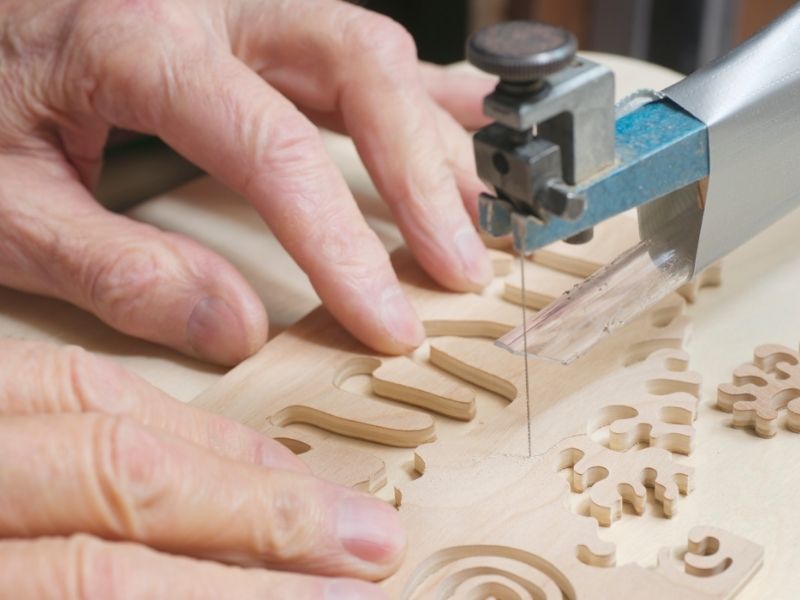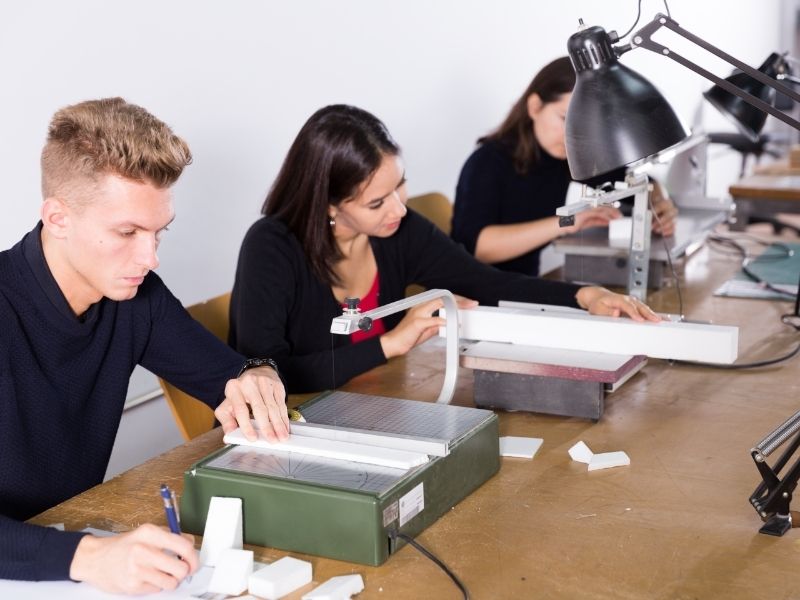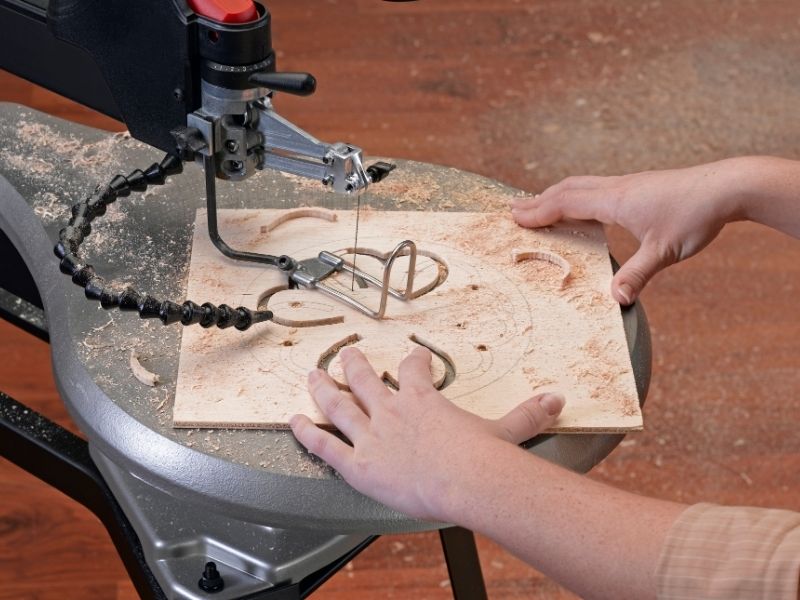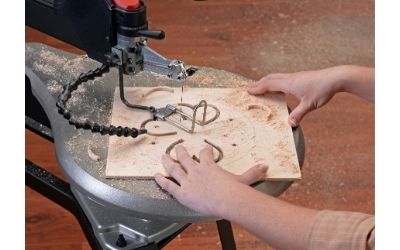
If you’re wondering ‘how much does a scroll saw cost‘ you’ve come to the right place. The answer to this question is dependent on the quality of saw, the brand and the features it has.
Remember that scroll saws, similar to bandsaws, table saws, and jigsaws, are designed to make intricate cuts in wood and metal, so you’ll need one that has all the features to meet the demands of your most regular cuts while still being kind to your budget.
Before you fork out your hard earned money though, as a starting point, it’s good to know the ins and outs of scroll saws. This will help you to know what you need to look for as there are many things to consider.
For example, how much throat length will you need? Some of you may be asking, ‘what is throat length?’ Also, you’ll need to consider how much power you’ll need, as well as blade size, tabletop tilt plus other things.
Having said this, it’s not as complicated as it sounds. To help you out, we tested a few of these ourselves, plus have commented on the saws based on our own personal experience from using them. We do not get paid to write reviews so these really are from our own perspective on what we think are the pros and cons of each model.
As always we encourage to read a lot of reviews and know what you’re looking for as it could be the case that another type of power tool is more suited to your needs.
At the end of our reviews, we have put together a buyer’s guide that addresses some of the basics to consider with scroll saws.
How Much Does a Scroll Saw Cost – Our Reviews
Best Scroll Saw Overall – Delta 40-694 Scroll Saw – Top Pick
elta 40-694 Scroll Saw I must admit, it’s pretty rare for us at the woodworkingpost.online to choose a Delta product as our top pick! Normally the Dewalt branded tool would easily eclipse a Delta power tool – however in this instance, the Delta is no doubt the better product of the two (plus the Delta is cheaper).
Like the Dewalt (reviewed below), this is also premium priced scroll saw that offers an excellent design feature more often found at this price point. This is of course the dual parallel-link arm design feature. This is awesome as it allows for a quiet and smooth operation. As a generally rule the parallel link provides less vibration over the parallel arm with all controls right in front. The arm also lifts and locks for easy tool-free blade changes. These blades are easier and much quicker to move from hole to hole as well with the parallel link feature.
One issue we noticed was that it wasn’t properly lubricated on arrival. This meant it was noisy and vibrated a lot. It’s amazing the difference a bit of synthetic grease makes (but really you shouldn’t have to do this on a brand new unit – especially for the price you pay). It might not be the case with all of them – but thought I’d mention it.
It has a decent 1.3-amp motor with variable speed from 400-1750 SPM. Plus a depth cut of 2⅛ inches combined with a bevel of 45 degrees in each direction. Lengths you can cut up to 20 inches allowing for a wide range of projects.
The dust system is pretty good. It’s adjustable helping you keep your cutting area clear and visible (not that scroll saws produce too much dust anyway).
The saw is suitable for those more experience as it’s easy to work on intricate projects without getting frustrated due to excess wobble and vibration. Plus the 5 year warranty is comforting and it’s cheaper than the Dewalt which makes a similar product.
On the downside? The silly manual it comes with isn’t all that user friendly. It definitely requires way more assembly than what is shown in the booklet (the hold down foot and inserting the screw needed for the tilt knob).
At the end of the day, the Delta is our top pick as the value is unbeatable for the features on offer, durability and it can be used by both the beginner and professional alike.
To check the price and read reviews of the Delta, 40 – 694, click here.
The Good:
- Parallel-link arm
- Tool-free blade clamp
- Upper arm lifts and locks into position
- Five-year warranty
- Table tilts 45 degrees each way
- Variable speed 400-1,750 SPM
The Bad:
- May need lubrication out of the box
- Premium price
Best Scroll Saw For Beginners – WEN 3921 Scroll Saw
This scroll saw is without doubt, best for beginners. It’s low in price, functions well and runs smoothly. The reason we think it’s best for beginners though is due to the design of the blade holders. We found it’s not very usable with pinless blades (although it won’t state this on the packaging). Really you would spend more time on fiddling around with the silly blade holder than making cuts.
But if you’re a beginner and If you’ve never used a scroll saw before and you just want to make a basic cut-out (rocking horse) or even a large-piece jigsaw puzzle as a gift, then this saw will do the job. It’s no trouble to place a pinned blade in the saw and made basic angles and shallow curves. It even comes with a couple blades.
The problem is more if you want to use pinless blades for more intricate cuts as the clamping mechanism definitely sucks. If you’re not looking to use a pinless blade, then it won’t be an issue. Just thought I’d mention this as you need to be aware of the pitfalls of each product.
Will also mention that the throat length is only 16 inches (again good for beginners) but we noticed that the blade can be turned sideways allowing for unlimited ripping. For this price, it’s definitely a handy feature.
The saw as you’d expect, is lightweight so you will need to mount it to a bench. Perhaps some 3/4″ plywood. This will ease any vibration.
The blower function is a little bit ordinary – but I don’t think it’s bad enough to be considered a deal breaker.
It does offer variable speed (400 – 1600 SPM) allowing control over your cuts. Plus the two-inch cut depth capacity should be enough for even detailed woodcutting.
Overall, due to its ease of use, low entry-level price, and two-year warranty, this saw gets our vote for the best scroll saw for beginners.
To check out the price and read reviews of the Wen 3921, click here.
The Good:
- Affordable price
- Table tilts 45 degrees left
- Variable speed 400-1,600 SPM
- Two-year warranty
The Bad:
- Features like blower (and even the light) aren’t the best
- Pinless blades are super tricky to use
Shop Fox W1713 Scroll Saw – Mid Range Price but Basic Saw
The Shop Fox 16-inch scroll saw is affordably priced and similar to the Wen listed above, it is best suited to beginners. It has a similar issue with pinless blades difficult to change, but works fine on pinned blades with a tool-less change system (will mention that they advertise it as being able to use pinless or pinned but in reality, it’s difficult to use for pinless blades).
At 1.2 amps it’s got plenty of grunt work to handle a fair amount of jobs – Pine, Maple and Oak won’t be a problem (even running at speed). Plus it makes straight cuts together with tight rounded corners without having to make relief cuts. Having said this, we did notice that at high speeds this saw tends to vibrate and bounce, making clean cuts more difficult.
The variable speed from 550-1,700 SPM is pretty decent with a standard depth of cut at 2 inches. Interestingly it has a gooseneck work light plus comes with a dust blower, and dust port. As the price is quite low, that’s a pretty decent feature set. The two-year warranty is another nice addition as an added bonus.
The biggest downside? The bevel function. Hard to believe but although this saw works well, it does not tilt! So if you want one that you can bevel, don’t buy this one. You’d be better off with the 16″ Wen above and they’re not that much different in terms of price either (the Wen is likely to be cheaper in fact).
To check the price and read reviews of the Shop Fox W1713, click here.
The Good:
- Affordably priced
- Work light
- Dust blower and dust port
The Bad:
- Advertised to use pinless blades but in reality they are hard to use
- No tilt function for beveled cuts
- Will vibrate and bounces at higher speeds
What to Look For When Buying a Scroll Saw – Our Buyer’s Guide

First of all, it’s good to know exactly what you’re after before you rush out and purchase a scroll saw.
Here are some basics to get you started.
You’ll need to know…..
- How do you turn the scroll saw ON AND OFF? Where is the button located? Is it convenient?
- Tip: I look for one with the power switch on the top so it’s easily accessible in case I need to turn it off in a hurry.
- Do you want VARIABLE SPEED control? Variable speed is a factor to consider depending on the type of material you are working with (metal/wood – hard vs soft etc). It’s good to be able to navigate between quick fast cuts or to slow it down for greater pision.
- Tip: ensure you know where the variable speed trigger is and for this switch to be different to your power switch (like a combo one).
- Have you considered THROAT SIZE? Throat size refers to the distance from the back of the blade to the very back ‘throat’ of the saw. You may look at the box and see: “16 inch scroll saw” or “30-inch scroll saw” – these numbers here are referring to the throat size.
- It is important because whatever throat size you have, you can cut a piece of wood double that length. For example, a 30-inch scroll saw can cut a 60-inch piece of wood. Therefore a 16″ scroll saw is pretty basic and best for beginners.
- If you’re new to woodworking, a 16” size would be fine to use with many professionals happy with a 20” or 21”. Don’t think that you will definitely need a 30” – you’ll pay more for it and it could just be overkill. At the end of the day, get the one that you think will suit your needs the best.
- What type of SCROLL SAW BLADE does your saw take? This is an important question as you’ll need the right blade for the right saw. Consider the following:
- Pinned – thicker blades used on thicker cuts of wood. This does not allow for finer cuts.
- Unpinned (or pinless)- generally more options when it comes to cutting wood. There are a bigger variety of pinless blades, designed to do tighter, more detailed cuts.
- Do you want a TOOLED OR TOOL-LESS BLADE CHANGE system? This can come down to personal preference but it is good to know how the blade mounts.

This is because, if you’re project requires many cuts, it’s going to be a pain in the backside to change the blade for every cut you make. Some tool blades require a few tools just to change the blade in and out. A toolless one is heaps easier and doesn’t require any tools to switch out the blade.
For this reason most experts prefer a tool-less blade (including myself and I’m a carpenter by trade), but you should know that the little mechanism used to change blades can sometimes strip out on you and have to be replaced. These pieces are not indestructible, so it’s better to get a quality saw that will last longer that the cheaper varieties.
- Have you considered SCROLL SAW BLADE TENSIONING? Remember you will need to tighten (and loosen) the blade from time to time. You need to know how to do this and access points as you don’t want the location to be inconvenient.
Some scrolls saws have levers, some have a cam, some have knobs at the back. These all function to tighten and loosen the scroll saw blade. Just so you know, many 16″ scroll saws have the tensioning lever or knob strictly at the back of the saw rather than at the head. This can make it awkward to get to when you’re trying to do a cut. You may end up tensioning your blade round the clock on almost every cut! So definitely consider
- Material (plastic or metal)
- How easy it is to tighten the blade
- What method is used – lever, cam, knob
- Location of tensioning mechanism
- What SIZE TABLE will the SCROLL SAW be placed on?
Conisder….
- Do you have enough room on your work bench or table to do your project comfortably? You will need to be able to freely spin the piece plus have it supported while you’re making cuts to the material
- Does the surface of your table create any resistance when you’re trying to work and move a piece? Remember, your table should be smooth and flat.
- How durable is your table? It needs to be strong. Tip: steer away from a wooden table and look for aluminium or cast iron ones instead. Much stronger.
- How does the scroll saw combat DUST COLLECTION? Honestly, this is an issue for all power tools (and a bug bear of bear that I pointedly address). I’m not sure if I know of any on the market that does an impeccable job at collecting dust. If I read reviews with users saying that the dust system sucks (literally and figuratively!) then I often go by this.
You may note that some have blow tubes, some have compressors, but what you really need to be sure of is whether the blow tube is flexible and can be moved so that it doesn’t blow dust directly onto your lap while cutting. Bear in mind, that there will be dust. The aim is to look for the most efficient system to combat this.
- How useful is THE HOLD DOWN FOOT? Is it sturdy and capable of holding down your project? I like it when the hold down foot is adjustable. Beginners particularly find the foot useful. A lot of pros don’t bother and it can even break more delicate/intricate pieces you are working on. Just something to keep in mind.
- What type of SCROLL SAW BLADE ROCKER ARM TYPE do you require? The scroll arm provides the strokes of the blade – eg it gives it the up and down action.
The arms vary from scroll to scroll. Some saws have one, solid arm that goes from the front to the back and handles all the movement for the blade. This arm pivots (along with the lower arm). Many feel that this is too unstable for making sensitive cuts. The upside? Scroll saws with a single arm are generally more budget friendly.
Other experts prefer smaller arms which work more like a cam and provide less vibration on the work table. I always look for the kind that provide the least amount of vibration.
- Do you want to RAISE THE TOP ARM? To answer this, you’ll firstly need to consider the type of projects you’re planning to do. A top lifting arm will benefit you if you are planning to do a lot of fret work (working from the top of the table down).
- Do you want TABLE TILT (aka blade tilt): Scroll saws can tilt in all sorts of ways – right, left or both right and left. Really what you need to find out is how accurate it is when making measurements (again check what reviewers say here). You need to consider the ease of adjustment and how solid it is once adjusted. Some tables stay flat and the blade/arm does the tilting.
- How about SCROLL SAW BLADE STORAGE? If you have several blades of different sizes, you need to consider where you’re going to store these blades. Really, it’s an added bonus if the one you want addresses this so it’s something to be mindful of.
- Will you need a WORK LIGHTS? Again another added bonus and not really a ‘must have’ as such. Obviously good lighting is essential, but you can create this with good lighting set up in your work shop for all projects you tackle. Whether it has a light or not is not a deal breaker for me.
- Will you need a TOOL STAND? Many scroll saws come with their own stand (but would cost more than one that doesn’t have one). If you do want a stand, consider one with adjustable legs. You do want to be sure you’re able to work at the right height for your needs. Remember you can always save money and make your own stand out of 2x4s.
- Will you scroll saw require LUBRICATION? This may not be an issue at all but something I’d thought I’d mention. Some scroll saws have greaseless bushings and bearings while others require lubrication. If it does, it will recommend this and it could be something you need to do after many hours of cutting.
Final Thoughts…..
Hopefully you found these 16 questions useful when weighing up what to look for when buying a scroll saw.
Remember to prioritise what’s most important versus the features that are more of a bonus than a must have.
As a starting point, consider your budget and remember that you generally get what you paid for. Having said that, you don’t want to over spend on something that has more bells and whistles for your cutting needs.
If you’re a beginner spend less and get a smaller throat size as this should suit your current needs. And also remember that all power tools need some time to get use to.
If you have any questions, we would love to help. Just contact us and we’ll be in touch!



